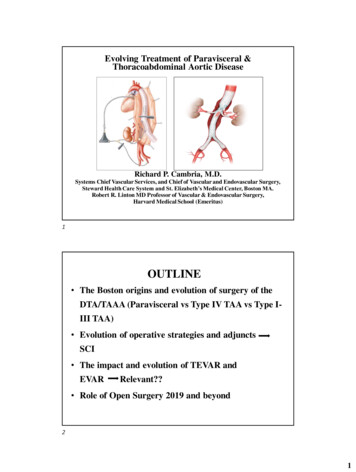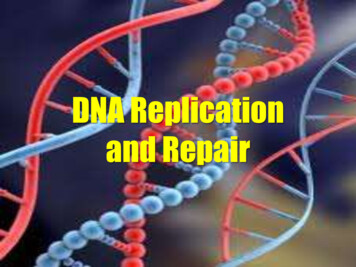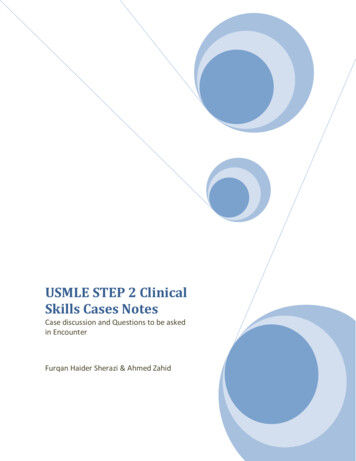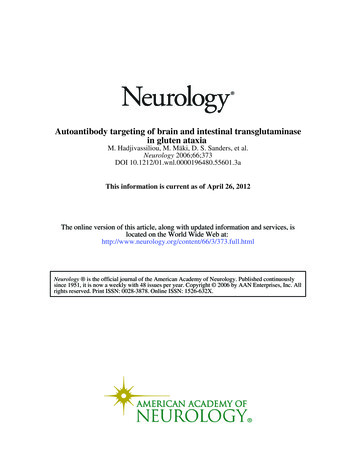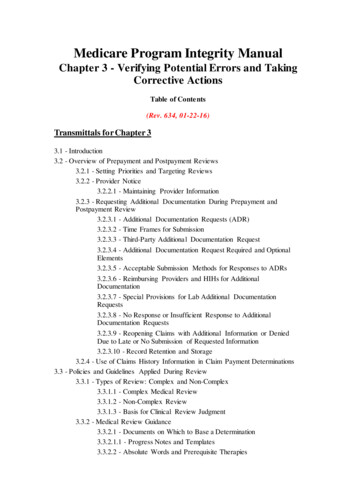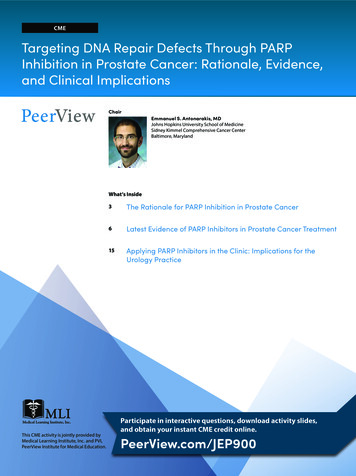
Transcription
CMETargeting DNA Repair Defects Through PARPInhibition in Prostate Cancer: Rationale, Evidence,and Clinical ImplicationsChairEmmanuel S. Antonarakis, MDJohns Hopkins University School of MedicineSidney Kimmel Comprehensive Cancer CenterBaltimore, MarylandWhat’s InsideThis CME activity is jointly provided byMedical Learning Institute, Inc. and PVI,PeerView Institute for Medical Education.3The Rationale for PARP Inhibition in Prostate Cancer6Latest Evidence of PARP Inhibitors in Prostate Cancer Treatment15Applying PARP Inhibitors in the Clinic: Implications for theUrology PracticeParticipate in interactive questions, download activity slides,and obtain your instant CME credit online.PeerView.com/JEP900
Activity InformationMedia: Enduring MaterialAccredited Activity Release Date: July 22, 2020Accredited Activity Expiration Date: July 21, 2021Time to Complete Activity: 60 minutesActivity DescriptionIn this activity, Emmanuel S. Antonarakis, MD, discusses the rationale fortargeting DNA repair defects through PARP inhibition and reviews recent safetyand efficacy evidence with PARP inhibitors in patients with prostate cancer. Healso highlights guidelines for genetic testing that is used to identify patientswho might benefit from PARP inhibitor therapy and explores using PARPinhibitors in the urology clinic.Target AudienceThis activity has been designed to meet the educational needs of urologists,oncologists, physician’s assistants, nurse practitioners, and other health careprofessionals involved in the management of patients with prostate cancer.Educational ObjectivesUpon completion of this activity, participants should be better able to: Describe the rationale for therapeutic targeting of DNA repair defects andthe mechanism of PARP inhibition in managing BRCA-mutant prostatecancer Review companion diagnostic tests that detect germline and somaticmutations within the DNA repair pathways Discuss the latest evidence with PARP inhibitors in advanced prostate cancerharboring DNA repair defects Identify patients with prostate cancer who may be candidates for clinicaltrial based therapeutic approaches, including studies testing combinationregimens with PARP inhibitor componentsProvidership, Credit, and SupportThis CME activity is jointly provided by Medical Learning Institute, Inc. and PVI,PeerView Institute for Medical Education.This activity is supported by independent educational grants fromAstraZeneca, Clovis Oncology, Inc., and Merck & Co., Inc.Physician Continuing Medical EducationThis activity has been planned and implemented in accordance withthe accreditation requirements and policies of the AccreditationCouncil for Continuing Medical Education (ACCME) through the jointprovidership of Medical Learning Institute, Inc. and PVI, PeerView Institute forMedical Education. The Medical Learning Institute, Inc. is accredited by theACCME to provide continuing medical education for physicians.The Medical Learning Institute, Inc. designates this enduring material for amaximum of 1.0 AMA PRA Category 1 CreditTM. Physicians should claim only thecredit commensurate with the extent of their participation in the activity.Faculty DisclosuresChairEmmanuel S. Antonarakis, MDProfessor of Oncology and UrologyJohns Hopkins University School of MedicineSidney Kimmel Comprehensive Cancer CenterBaltimore, MarylandPlanning Committee DisclosuresThe planners from Medical Learning Institute, Inc., the accredited provider, andPeerView Institute for Medical Education, the joint provider, do not have anyfinancial relationships with an ACCME-defined commercial interest related tothe content of this accredited activity during the past 12 months unless listedbelow.Content/Peer Reviewer DisclosuresThe following Content/Peer Reviewer has nothing to disclose:Christopher Jakubowski, MDDisclosure of Unlabeled UseThis educational activity may contain discussions of published and/orinvestigational uses of agents that are not indicated by the FDA. The plannersof this activity do not recommend the use of any agent outside of the labeledindications. The opinions expressed in the educational activity are those ofthe faculty and do not necessarily represent the views of the planners. Pleaserefer to the official prescribing information for each product for discussion ofapproved indications, contraindications, and warnings.DisclaimerParticipants have an implied responsibility to use the newly acquiredinformation to enhance patient outcomes and their own professionaldevelopment. The information presented in this activity is not meant to serveas a guideline for patient management. Any procedures, medications, or othercourses of diagnosis or treatment discussed or suggested in this activity shouldnot be used by clinicians without evaluation of their patient's conditions andpossible contraindications and/or dangers in use, review of any applicablemanufacturer's product information, and comparison with recommendationsof other authorities.Method of ParticipationThere are no fees for participating in or receiving credit for this accreditedactivity. For information on applicability and acceptance of continuingeducation credit for this activity, please consult your professional licensingboard.A statement of credit will be issued only upon receipt of a completed activityevaluation form and will be emailed to you upon completion. You will receiveyour certificate from email@email.peerviewpress.com. If you have questionsregarding the receipt of your emailed certificate, please contact via email atinfo@PeerView.com.About This CME ActivityPVI, PeerView Institute for Medical Education, and Medical Learning Institute,Inc. are responsible for the selection of this activity’s topics, the preparationof editorial content, and the distribution of this activity. Our activities maycontain references to unapproved products or uses of these products incertain jurisdictions. The preparation of PeerView activities is supported byeducational grants subject to written agreements that clearly stipulate andenforce the editorial independence of PVI and Medical Learning Institute, Inc.The materials presented here are used with the permission of the authorsand/or other sources. These materials do not necessarily reflect the views ofPeerView or any of its partners, providers, and/or supporters.Emmanuel S. Antonarakis, MD, has a financial interest/relationship or affiliationin the form of:Consultant and/or Advisor for Amgen Inc.; Astellas Pharma US, Inc.; AstraZeneca;Bayer Corporation; Dendreon Pharmaceuticals LLC; Clovis Oncology; Eli Lillyand Company; ESSA Pharma, Inc.; GlaxoSmithKline; Janssen Pharmaceuticals,Inc.; Medivation; Merck & Co., Inc.; and sanofi-aventis U.S. LLC.Grant/Research Support from AstraZeneca; Bristol Myers Squibb; CelgeneCorporation; Clovis Oncology; Dendreon Pharmaceuticals LLC; Genentech, Inc.;Janssen Pharmaceuticals, Inc.; Johnson & Johnson Services, Inc.; Merck & Co.,Inc.; Novartis Pharmaceuticals Corporation; sanofi-aventis U.S. LLC; and TokaiPharmaceuticals Inc.Other Financial or Material Support from Qiagen as a patent holder/licenser.Go online to complete the post-test and evaluation for CME creditPeerView.com/JEP9002
Targeting DNA Repair Defects Through PARPInhibition in Prostate Cancer: Rationale, Evidence,and Clinical ImplicationsThe Rationale for PARP Inhibitionin Prostate CancerDr. Antonarakis: Hello, my name is Dr. Emmanuel Antonarakis,and I’m professor of oncology and urology at the Johns HopkinsUniversity School of Medicine and Sidney Kimmel ComprehensiveCancer Center.Welcome to this educational activity entitled Targeting DNA RepairDefects Through PARP Inhibition in Prostate Cancer, designed toimprove the management of patients with advanced prostatecancer. So let’s move right into the talk here.Advancing Prostate Cancer (PCa) Therapy:New Targets Novel Approaches1Hallmarks of Cancer1. Adapted from Hanahan D, Weinberg RA. Cell. 2011;144:646-674.On the first slide, what I’m showing is the classic Weinberg andHanahan Hallmarks of Cancer figure. And this goes to show thatthere are many targetable pathways that a cancer cell is dependenton for its growth. And the PARP inhibitors focus on the genomicinstability and the mutability, the high mutation rate that is presentin many cancers, and this will be the focus of this presentation.So first of all, how common are these so-called DNA repair genemutations in prostate cancer and why are they relevant? And thiswas quite an unexpected discovery that was made about 4 or 5years ago now, and there are many publications and this slideshows two of the key publications.On the left side, I’m showing the somatic DNA repair mutations,in other words, the ones that are found inside the prostate cancercell, and on the right side, I’m showing the germline mutations,which are the inherent mutations that are found in patients whosubsequently develop prostate cancer. And the punchline is thatapproximately one-quarter of all prostate cancers have a somaticDNA repair gene mutation. Of those 23%, the most prevalentmutation is BRCA2, followed by ATM.What was perhaps a bit more surprising is that there are many,many germline mutations in prostate cancer. And we have knownfor a long time that these were present in breast and ovariancancer, but recent data suggest that 12% of men with metastaticprostate cancer have one or more germline mutations, meaninginherited mutations in one of these DNA repair genes, and that isshown in the pie chart on the right. BRCA2 is the most commonlymutated germline gene, followed by ATM, followed by some otherrare genes.And this is important in the context of PARP inhibition becausethese DNA repair mutations can become a liability and they canmake drugs like PARP inhibitors work in cancers that have thesehomologous recombination gene mutations or in patients whohave inherited germline homologous recombination mutations.Synthetic LethalityHow to Selectively Stop BRCA-Mutated Cancers1 BRCA: “copy editor”; homologous recombination PARP: “spell check”; base excision repairDNA Repair Gene Alterations (Somatic and Germline)Are Common in Metastatic PCa1,2GermlineSomatic DNA damage (SSBs)PARP inhibitionImpairs base excision repairDNA replication (DNA DSBsor replication fork collapse)23% of metastatic castration-resistant prostatecancers harbor DNA repair alterationsThe frequency of DNA repair alterations increaseswith disease progressionNormal cell with functional HR pathwayHR-mediated CellDNA repair survivalHR-deficient tumor cell (BRCA deficient)CelldeathImpaired HR-mediatedDNA repairTumor-selective cell death (synthetic lethality)1. Banerjee S et al. Nat Rev Clin Oncol. 2010;7:508-519. 12% of men with metastatic prostatecancer have a germline DNA repair defectAge and family history do not affectmutation frequency1. Robinson D et al. Cell. 2015;161:1215-1228. 2. Pritchard CC et al. N Engl J Med. 2016;375:443-453.Go online to complete the post-test and evaluation for CME creditAnd the way in which these PARP inhibitors work is a term calledsynthetic lethality. Let me just explain that for a second because it’squite important for understanding the way PARP inhibitors work.There are two ways that any cell, including a cancer cell, can fixDNA damage. The first is to fix one strand at a time, a single-strandPeerView.com/JEP9003
Targeting DNA Repair Defects Through PARP Inhibition in Prostate Cancer: Rationale, Evidence, and Clinical ImplicationsDNA repair. The second is to fix both strands of the double helix atonce; that is called a double-strand repair.The main protein or enzyme that is responsible for double-strandbreaks are the homologous recombination genes, of which themost famous is BRCA1 and BRCA2. However, the single-strand DNArepair is fixed primarily by PARP1, and synthetic lethality meansthat both the single-strand repair pathway and the double-strandrepair pathway need to be crippled or inactivated in order for thecell to die.In the case of a cancer that has a BRCA2 mutation, or a patient whohas an inherited BRCA2 mutation, that cancer has an inactivationof homologous recombination because of a genetic mutationthat is found. And in that context, blocking PARP1 with a drug, aPARP inhibitor, then subsequently wipes out that cell’s ability tofix single-strand damage. So now this cell has both double-strandand a single-strand DNA damage, which leads to catastrophic DNAdamage and subsequent cell death. So this is what is known assynthetic lethality and this is the broad mechanism by which PARPinhibitors work.BRCA2 Carriers With PCa Have Worse Prognosis1,2NoncarriersFamily History Is a Real Risk FactorA father or brother with prostate cancerdoubles a man’s risk of prostate cancerA mother or sister with breast cancerdoubles a woman’s risk of breast cancerA mother or sister with ovarian cancercan affect a man’s risk of prostate cancerAnd this is where the discussion about family history is very, veryimportant. And a lot of us, including myself, we used to alwaysask about family history of prostate cancer in our clinics but weweren’t very good, at least I wasn’t, at asking about family history ofbreast cancer or ovarian cancer. And it turns out that this was a bigmistake because the same genes that predispose to breast cancerand ovarian cancer in females are one and the same that alsopredispose to prostate cancer in men.So of course, we should still be asking every patient “Do you havea father or a brother or a son with prostate cancer,” but beyondthat we should be asking the second question which is, “Do youhave a mother or a sister or a daughter with breast cancer orovarian cancer?” And by asking this more broad question, insteadof focusing only on the prostate cancer family history, we mightcapture a larger number of these genetically-inherited forms ofprostate cancer.Cascading ImpactMedian survival not reached after a median of 64-mo follow-up.1. Castro E et al. J Clin Oncol. 2013;31:1748-1757. 2. Castro E et al. Eur Urol. 2015;68:186-193.aOne of the interesting early findings in patients that had germlineBRCA2 mutations is that those men with germline BRCA2 mutationswho developed prostate cancer tended to have worse outcomes,as shown on this slide. Not only did they have generally youngerage of onset of their cancer and generally higher Gleason scores,but they also had a shorter metastasis-free survival and shorteroverall survival if they had a germline BRCA2 mutation comparedwith no BRCA2 mutation.The BRCA1 mutations in prostate cancer are relatively more rare,but their outcomes are sort of intermediate between the wild typepatients and the BRCA2-positive patients. 1:10 mencarries aninherited DNArepair genemutationThis has implications not just for the patient but also for thepatient’s family members. This is what is called the cascade effect,also known as cascade testing. So if a man with prostate canceris himself diagnosed with a germline DNA repair gene mutationsuch as BRCA2, then each of his first-degree relatives of both sexes,meaning parents, siblings, and children, have a 50% chance of alsoinheriting the same DNA repair gene mutation.This is important in the case of BRCA1 and BRCA2 because, ofcourse, in males these gene mutations can predispose to prostatecancer, but in females, these genes can predispose to breast andGo online to complete the post-test and evaluation for CME creditPeerView.com/JEP9004
Targeting DNA Repair Defects Through PARP Inhibition in Prostate Cancer: Rationale, Evidence, and Clinical Implicationsovarian cancer. And in the case of BRCA2, can also predispose tomelanoma and also pancreatic cancer in both sexes.So, on the one hand, while finding a BRCA2 germline mutation ina male with prostate cancer can potentially help to prioritize thatpatient for PARP inhibitor therapy or maybe even platinum therapy,there are also family implications for this gentleman’s first-degreerelatives, meaning parents, siblings, and children.prostate cancers, now the panel recommends somatic testing in allpatients with metastatic disease, and it should also be consideredin patients with regional prostate cancer - again, meaning thosethat have positive lymph nodes. So again, this is virtually everypatient that a medical oncologist sees and most patients that aurologist will see in his clinic.NCCN (V 2.2020) Guidelines for Genetic Testing1Germline Testing Germline genetic testing isrecommended for patients withprostate cancer and any of thefollowing: High-risk, very high-risk,regional, or metastaticprostate cancer Ashkenazi Jewish ancestry Family history of high-riskgermline mutations (eg,BRCA1/2, Lynch mutation) A positive family historyof cancerSomatic Tumor Testing Recommend evaluating tumor foralterations in homologousrecombination DNA repair genes,such as BRCA1, BRCA2, ATM,PALB2, FANCA, RAD51D,CHEK2, and CDK12, in patientswith metastatic prostate cancer Can be considered in men withregional prostate cancer Testing for MSI-H or dMMR isrecommended in patients withmetastatic CRPC, and should beconsidered in patients withregional or castration-naïvemetastatic prostate cancer1. NCCN Clinical Practice Guidelines in Oncology: Prostate Cancer. Version 2.2020. https://www.nccn.org/professionals/physician gls/pdf/prostate.pdf.The NCCN guidelines have been very quick to adopt guidelinesboth for germline testing and somatic testing, as I’m showing onthis slide. And about two years ago, this wasn’t even discussed onthe panel and in the current version, which is version 2.2020, whichwas issued in May of 2020, there are now very well-developedguidelines both for germline testing, as shown on the left, andsomatic testing, as shown on the right.So the current NCCN prostate cancer guidelines recommendgermline testing for every patient with prostate cancer who hashigh-risk, localized disease or very high-risk localized disease, orpatients who have a regional spread, meaning a lymph nodepositive prostate cancer, or patients that have metastatic prostatecancer. If you turn that on its head, it’s basically everyone except forthe low-risk and very low-risk.In addition to that, anyone that has an Ashkenazi Jewish ancestry,regardless of the risk, even if they are low-risk or very low-risk, theyare recommended to undergo germline testing. And in addition,anyone who has a known family history of a BRCA1, BRCA2, or amismatch repair mutation, in other words the Lynch syndrome,and anyone who has a strong positive family history, not just ofprostate cancer but other cancers as well, such as breast, ovarian,and pancreatic cancer, should also undergo testing.So when you actually sum it all up, virtually every patient accordingto NCCN guidelines, with very few exceptions, is recommendedto undergo germline testing, typically at the time of the firstdiagnosis.Moving over to somatic testing, in other words, tumor testing.Because of the FDA approval of PARP inhibitors and because ofthe availability of pembrolizumab as well for the MMR-deficientGo online to complete the post-test and evaluation for CME creditPeerView.com/JEP9005
Targeting DNA Repair Defects Through PARP Inhibition in Prostate Cancer: Rationale, Evidence, and Clinical ImplicationsLatest Evidence of PARP Inhibitorsin Prostate Cancer TreatmentMany PARP Inhibitors Are Being Tested in PCa1Properties of PARP 34.5244.3380.8320.4323.4PARP1 IC505 nM1.2 nM0.56 nM3.8 nM0.65 nMPARP2 IC501 nM0.41 nM0.15 nM2.1 nM0.08 nM TrappingSo let’s start with olaparib, and this is the one that really was thefirst in the field to be tested in prostate cancer in any systematicway. And this paper that I’m showing here is The New EnglandJournal of Medicine paper from 2015. This was the first study ofolaparib in approximately 49 patients with advanced metastaticcastration-resistant prostate cancer, and this was an unselectedpopulation, meaning that patients with, as well as without, DNArepair gene mutations w
Jul 22, 2020 · PARP inhibitor, then subsequently wipes out that cell’s ability to fix single-strand damage. So now this cell has both double-strand and a single-strand DNA damage, which leads to catastrophic DNA damage and subsequent cell death. So this is what is known as synthetic lethality and this is the broad
